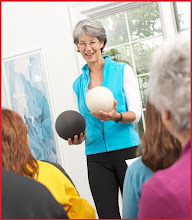Think (and Act) Outside the Box and You Can Feel Better with Corrective Exercise!
This almost sounds like the start to an infomercial except I did not finish the opening line with "in 10 days"! So what does "thinking and acting outside the box" have to do with feeling better (less pain and inflammation, more energy, less body/mind stress)? You know the saying that goes something like "if you keep doing the same thing and getting the same result, try something different" - Corrective Exercise is the "something different", the "think and act outside the box"!
Most injuries are connective tissue (fascial) injuries, not muscular injuries - so how do we best train to prevent and repair damage and build elasticity and resilience into our bodies? There are 10 times more sensory nerve endings in your fascia than in your muscles; therefore, how do we change the fascia as well as the muscles? By taking a different approach to exercise (and all functional body movement) with Corrective Exercise! We must train for fascial fitness! New research reinforces the importance of fascia, other connective tissue, and the movement "brain and the evidence all points to a new consideration within overall function of the body.
The "traditional" (old and outdated) methods used to reduce and eliminate soft-tissue pain and dysfunctional movement patterns in the body do not "heal the body"; in fact, it often makes the problems worse. Corrective Exercise uses a simple three-part approach to re-teach and re-program cues between the the soft tissue, the muscles, the brain, and the nervous system so that you can move forward with sustainable success to your active life. This approach uses an in-depth assessment, self-myofascial release, active stretching, and specific body-weight-only movement patterns through a simple system designed specifically for you that you can replicate at home.
Think this sounds "too good to be true"? You may wish to speak to some of the many clients who have done Corrective Exercise for low back pain, SI joint pain, hip pain, knee pain, neck and upper back pain, foot pain, etc. They are happy to share their good news with you (references provided upon request)!
I will, however, tell you one client's story. On March 18, an 81 year old woman with chronic back pain and a limping walk for the last 13 years following a surgery to insert rods in her low back to "eliminate" her pain came for her assessment. At assessment: On a 1-10 pain scale (10=the worst you can imagine), she reported a level "9" pain (9=severe enough that it makes you stop in the middle of an activity or not be able to complete it at all; difficult to think of anything else but your pain). She was unable to spend more than 30 minutes on her feet due to the pain. She had 3 goals: decrease the pain and associated fatigue, have ability to walk for one mile for enjoyment and exercise, and walk up and down a hill to get access to the lake from her summer cottage without needing assistance or limping. Exactly 8 weeks later on May 18, this woman reported having a pain level of "0-1" (0-1=very little or barely noticeable pain) and has reduced fatigue. She is able to walk up and down the hill at the lake without limping or pain or assistance. She continues to pursue her "walk one mile" goal and at present is stationary cycling for 10-15 minutes followed by 10 minutes of outdoor walking every day.
I applaud this woman and am happy for her; she chose to "think and act outside the box". Please consider One-to-One Corrective Exercise; if this woman can do it, so can you!
Monday, October 17, 2011
Subscribe to:
Post Comments (Atom)


No comments:
Post a Comment